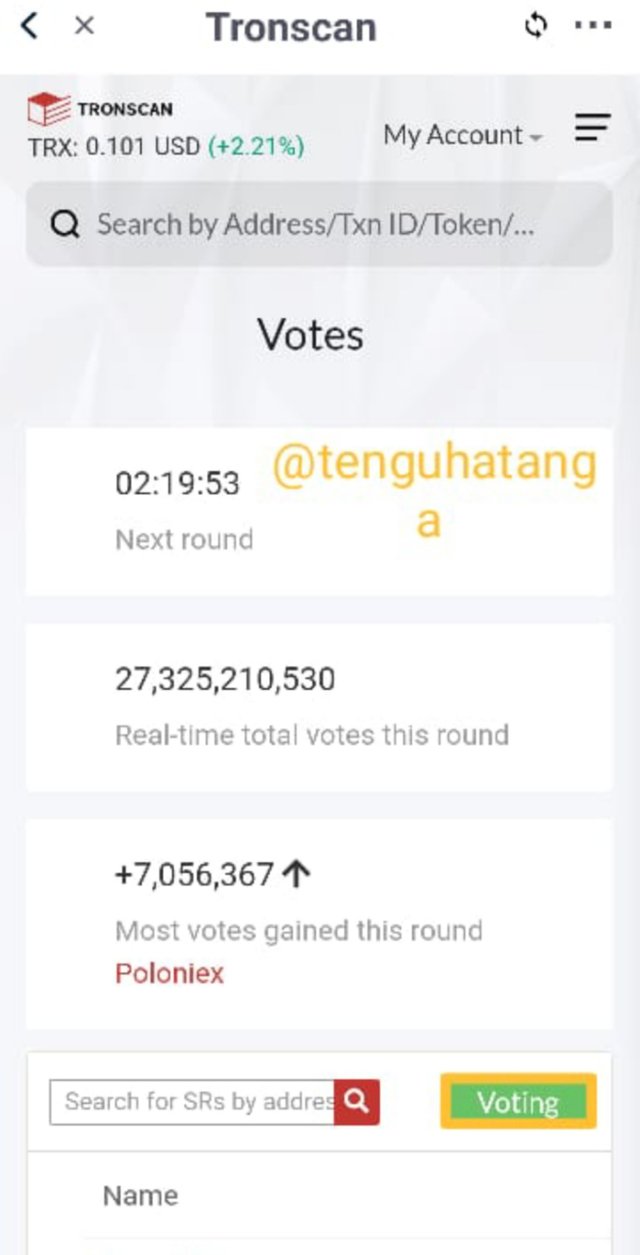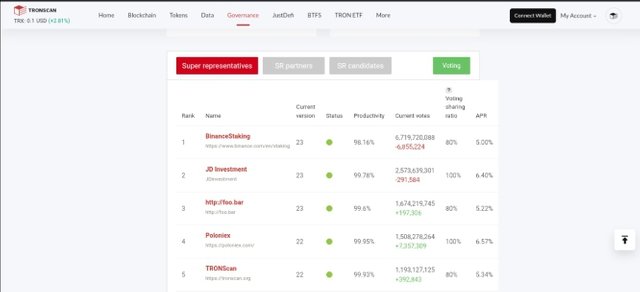
The Tron ecosystem is governed majorly by three sets of individuals who are voted by users of the Tron platform for their different activities. These sets of individuals are selected using a systematic process of voting that follows the Delegated Proof of Stake (DPoS) consensus algorithm which runs continuously on the ecosystem and seeks increase transaction speed and block creation while also building a decentralized structure of the blockchain for users. Users are charged with the responsibility to vote for the replacement of any of the and vote for the persons among the top governing body that will validate transactions.
In a hierarchical order, the Tron ecosystem governance comprises of Super Representatives, Super Representative partners and Super and Representatives Candidates
Let's look into who they are and their roles in the Tron ecosystem.
Who are Super Representatives, SR partners and SR candidates? (The Governance of the TRON Ecosystem)
Super Representatives
Also called witnesses, these are individuals in the top tier of witnesses who have been voted the most in the vote cast to elect the governing body for the Tron network. There are a total of 27 Super representatives selected for every vote cast. They are charged with the responsibility of validating transactions and producing blocks. They have the right not to include certain transactions in a block but they are not to change the details included in a transaction. They are rewarded with a number of TRX for every block they produce.
Individuals in this group have a continuous treat to lose their reputation and income if they indulge in wicked acts of removing the details of a transaction as votes are continuously cast every six hours. In the long run, some of them who are found not to be doing well are replaced.
Super Representative Partners
These are individuals that are ranked next to the super representatives by votes. The votes of these individuals do not reach those of the super representatives, so they do not make the list of block producers and transactions verifiers. They are ranked from number 28 - 127 in a hierarchy.
Super representative partners are also called delegates. Super representative partners are trusted individuals charged with the responsibility to maintain the network and oversee the governance, efficiency and effectiveness overall of blockchain network.
They can propose for a change in the size of the block or the pay of super representatives for their work of block production and transaction verification. Once they propose changes like this, users can now vote to effect the change they craved for. They are rewarded with TRX for there roles.
Super Representative Candidates
These are sets of individuals who were candidates for Super representatives but did not have enough votes to be SRs nor SRs Partners. They are usually in hierarchical order by votes from 128 down to the list. In the Tron ecosystem, super representative candidates vote for proposals from SR partners for changes that need to be installed in the system. By their performance and activities and with the possession of the minimum required tokens for staking in the network, they are also voted for and can therefore walk up to be SRs. They are not rewarded but they still use their TRX to vote for SRs and use their TRX to support others to vote for SRs they believe would be better SRs.
What’s the difference between DPOS and POS consensus mechanisms?
DELEGATED PROOF OF STAKE CONSENSUS ALGORITHM
DPoS is a method of reaching consensus among miners and block producers in a blockchain that involves a democratic way of determining validators and block producers.
It involves an electioneering process that accommodates even the smallest token holder to be the part of the decider of witnesses. DPoS was developed to work on the flaws of PoS
Four Steps are involved in reaching consensus in DPoS.
Witnesses or super representatives who produce blocks are elected by stakeholders (SR candidates)
Witnesses participate in a round-robin rotation with a number of blocks equal to the number of witnesses. This maintains trustworthiness by turning each round into a competitive market economy.
Witnesses validate and broadcast blocks
This way, coonsensus is reached by all witnesses, and the process starts all over again.
PROOF OF STAKE CONSENSUS ALGORITHM
Proof of Stake consensus algorithm is a method of reaching agreement between miners in a blockchain that has to do with miners staking a particular part of their assets to be able to be considered to validate a block.
The Proof of Stake (PoS) is a deterministic idea that basically asserts that a person can only mine or validate new blocks in the amount of money in their staking account.
It indicates that the more coins you have, the more mining power you have, i.e., the more transactions you can validate to get block rewards, the more coins you have in your wallet.
DIFFERENCES BETWEEN DPoS and PoS
| DPoS | PoS |
|---|---|
| DPoS system has no minimum stakeholder token requirement to participate in an election to elect block producers | PoS has a minimum stakeholder token requirement to be considered for a block producer. |
| In DPoS, everyone in the system votes to elect the block producers | In PoS selected few determines the block producers. |
| Stakeholders/users vote weight is proportional to their stake in DPoS | Stakeholders block production is tied to the the token in their staking account. |
| DPoS was developed to for a more efficient PoS | PoS was developed to have a more effecient PoW. |
| Power is always in the hands of stakeholders; they have the ability to replace any witness | Power is kept in the hands of an authority which determines witnesses. |
| Decentralization is fully possible as the centralized components can be changed by stakeholders in DPoS system | Decentralization is not fully possible in PoS. |
| DPoS is more secured in the sense that witnesses can be changed by stakeholders if they indulge in malicious acts that are harmful to the system despite their influence | It is less secured compared to DPoS in the sense that witnesses can use their influence in the network to remain being witnesses even if they do things harmful to the system. |
| Cryptocurrencies whose projects are built on the DPoS algorithm are **Steem, Nano, Eos Tezos, Carano, and Ark, Bitshare, ** | Cryptocurrencies whose projects are built on the PoS algorithm are NEO, STRATIS , LISK, PIVX, OKCash, and NAVCOIN. |
Write a Step by Step tutorial showcasing how to stake/freeze TRX and vote for SRs
For a user or stakeholder to vote SR, there is a requirement for Tron Power. Tron Power is a firm of staked TRX used for voting.
To vote for a Super representative, one first have to stake some TRX that would be used for the voting. The following steps can be taken to stake TRX.
TRX staking is done on Tronscan. Therefore access the tronscan from TronLink; On the TronLink homepage, click on click on discoveries and click on tronscan on the next page.
This connects the TronLink wallet to Tronscan automatically.


On the Tronscan homepage, click on the three lines (menu bar) and click governance.


Click votes and on the votes page, click on voting, and then click on obtain.



Enter the amount of TRX to be staked (I entered 4 TRX) and click on stake.

An authorization page will come up, click continue and on the next page, click confirm.


Enter password for your TronLink and click done.

A page that shows the success of the transaction would be shown. This way, you have successfully staked.

How to Vote for a Super Representative
To vote for Super Representative, go back to the votes page and click on voting.

Enter the Tron Power (staked TRX) you wish to use for the voting. I entered 4 in my case and clicked voting.

An authorization page would appear, click continue. On the next page click confirm to confirm the transaction


Enter your TronLink password and click done.

The next page shows the success of the transaction.

CONCLUSION
The governance of the Tron Ecosystem is a follows a democratic process of electing super representatives that are charge with the function of producing blocks. A totals of 27 SRs exists in the system every 6hours and are replaced by others deemed fit among SR partners and SR candidates judging by votes. This consensus algorithm used by Tron Ecosystem is called **Delegated Proof of Stake.
The SR partners are numbered in a hierarchy from 28 to 127 while SR candidates are numbered from 128 to the list by votes.
SRs, SR partners and and SR candidates all can propose for a change in any part of the network they feel should be changed. They all work to make sure the Tron ecosystem is functioning optimally and in all efficiency.



Hi @tenguhatanga
Thanks for participating in the Steemit Crypto Academy
Feedback
Total| 7.5/10
This is good work. Thanks for taking the time to learn about the governance of the Tron ecosystem.
Downvoting a post can decrease pending rewards and make it less visible. Common reasons:
Submit